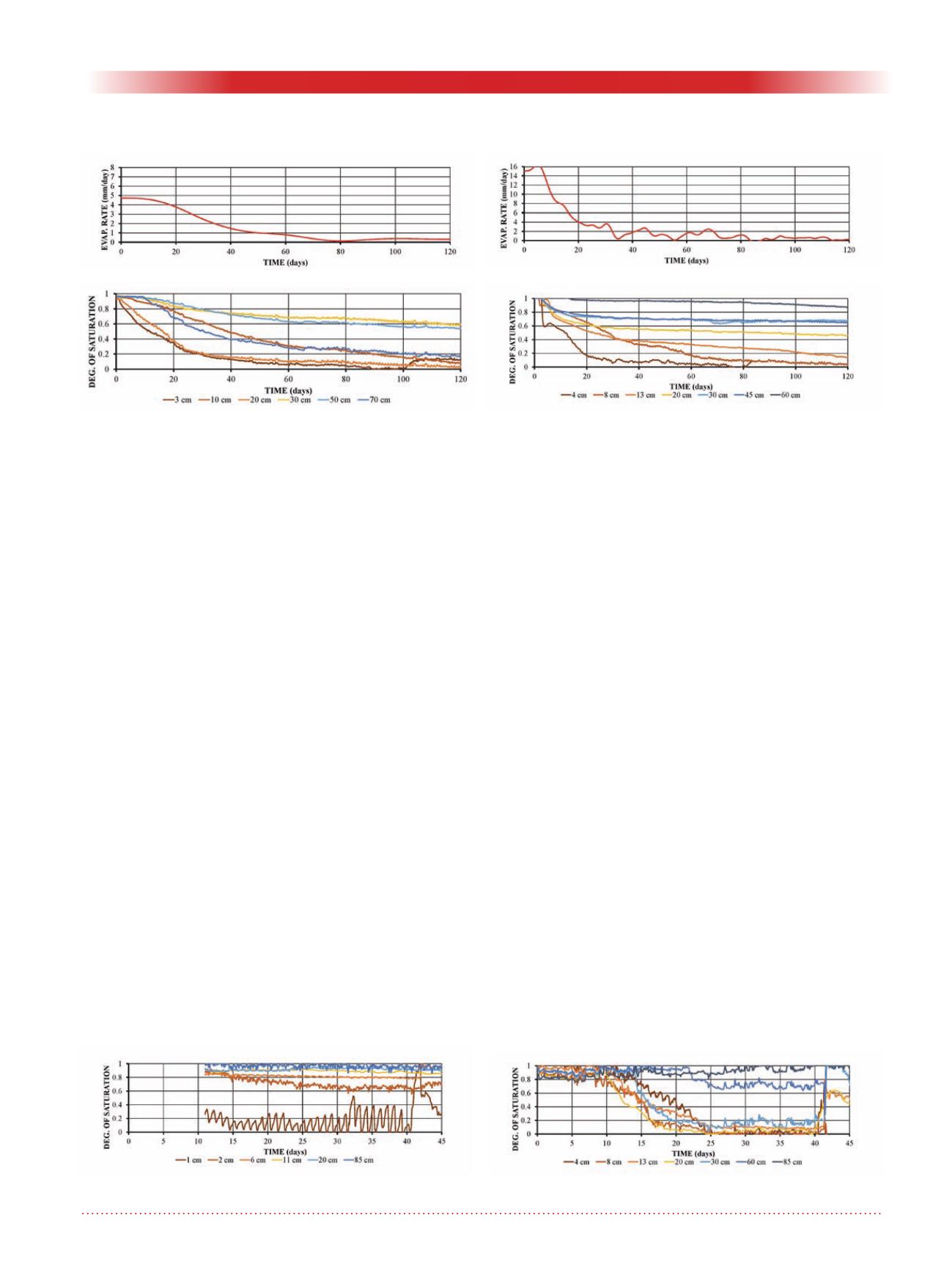
Geotechnical News • June 2018
39
WASTE GEOTECHNICS
tailings were limited, apart from very
high values measured at 3 cm depth.
After 120 days of desiccation, the top
30 cm of the sand tailings was dry,
and some desaturation had reached
a depth of 70 cm. Cumulative water
loss was about 18 cm, indicating an
average gravimetric moisture content
for the desaturated upper 70 cm layer
of 22.0%. Accompanying desicca-
tion, the surface of the sand tailings
shrunk 9.5 cm, indicating an average
dry density for the desaturated layer of
1.67 t/m
3
.
For the slimes, three desiccation stages
are also evident from the evaporation
rates in Figure 2b. An initially very
high evaporation rate of about 16 mm/
day lasted for about 5 days, until the
surface started to crack and the slimes
underwent significant shrinkage. The
evaporation rate decreased rapidly
from days 5 to 70, and beyond day
70 was near-zero. Matric suctions
were measured in the slimes to 60 cm
depth. After 120 days of desiccation,
the top 13 cm of the slimes was dry,
and some desaturation had reached a
depth of 60 cm. Cumulative water loss
was about 35 cm, indicating an aver-
age gravimetric moisture content for
the desaturated upper 60 cm layer of
30.5%. Accompanying desiccation, the
surface of the slimes shrunk 15 cm,
indicating an average dry density for
the desaturated upper layer of 2.25 t/
m
3
.
Rooftop column results
The rooftop columns have been run
for 45 days, and the results are shown
for the sand tailings and slimes in
Figures 3a and 3b, respectively. The
potential evaporation rates showed
daily fluctuations of up to 8 mm/day
during daylight hours (with maximum
ambient temperatures reaching 30
o
C)
and dropping to zero during the night
due to condensation. For the sand
tailings, desiccation started at day 11
when the surface water had evapo-
rated, was largely limited to the upper
6 cm, and was initially most pro-
nounced at 1 cm depth. Rainfall events
occurred at days 40 (about 40 mm)
and 44 (minor rainfall), which wet up
the desiccated surficial sand tailings.
Matric suctions in the sand tailings
were negligible. After 40 days of des-
iccation, only the top 1 cm of the sand
tailings was dry, and some desatura-
tion had reached a depth of only 6 cm.
Cumulative water loss was negligible,
since drying was limited to very shal-
low depth. Accompanying desiccation,
the surface of the sand tailings shrunk
only 2.75 cm, indicating an average
dry density for the desaturated upper
layer of 2.50 t/m
3
.
For the slimes, desiccation was largely
limited to the upper 30 cm, and was
initially most pronounced at 1 cm
depth. The rainfall event at day 40 wet
up the desiccated slimes to a depth of
30 cm. Matric suctions in the slimes
corresponded to the daily fluctuations
in evaporation rate and saturation, and
rainfall events, and reached 60 cm
depth. After 40 days of desiccation,
the top 30 cm of the slimes was dry,
and some desaturation reached a depth
of 60 cm. Cumulative water loss was
about 15 cm, indicating an average
gravimetric moisture content for the
desaturated upper layer of 50.0%.
Accompanying desiccation, the sur-
face of the slimes shrunk 14 cm, indi-
cating an average dry density for the
desaturated upper layer of 2.18 t/m
3
.
Figure 2a.
Laboratory sand tailings column.
Figure 2b.
Laboratory slimes column.
Figure 3a. Rooftop sand tailings column.
Figure 3b. Rooftop slimes column.


